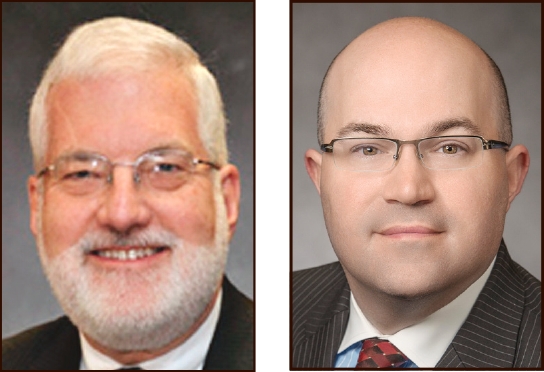Attorney's Column
Court: ‘Adjoining’ Properties to be Protected During Excavation Need Not Be Abutting
By THOMAS H. WELBY, P.E., ESQ. and GREGORY J. SPAUN, ESQ.

It has long been the law that owners and contractors who perform construction activities on a property can be held liable for damages caused to neighboring properties as a result of construction. The initial theory was straightforward negligence, with the contractor being held directly responsible for any negligent activities that result in damage, and the owner held vicariously liable for its retained contractor’s acts.
However, as structures and construction became more complex, not all damages remained apparent (or above ground). Neighbors were no longer as concerned about the tree that fell across the property line and onto their roof as they were about excavation that causes subsidence and damage to their foundation. In response, statutes were enacted that imposed absolute liability on those who excavate (initially deeper than 10 feet, and now regardless of depth) in the course of building.
The latest version is Section 3309 of the New York City Building Code, which provides that “Adjoining public and private property, including persons thereon, shall be protected from damage and injury during construction or demolition work,” and that “the person who causes such [excavation] to be made shall, at all times during the course of such work and at his or her own expense, preserve and protect from damage any adjoining structures.”
In the recent case of 7-11 E. 13th Street Tenants Corp. v The New School, an appellate court clarified that the term “adjoining” does not require that the properties physically abut, or share any boundary, and that nearby structures were similarly protected.
Background
The New School is a college in New York City, and in 2009 it commenced to undertake the construction of a 16-story University Center to provide a new focal point for “our downtown New York City campus—[with] the forward-thinking design reflect[ing] The New School’s commitment to creativity, innovation, and social engagement.” The school retained engineers to design the project, including its support of excavation aspects, and construction ultimately commenced.
In 2010, tenants of the plaintiff 7-11 East 13th St. Condominium began to complain of cracks in the walls and ceilings, and uneven and torqued doors throughout the building. Ultimately, it was determined that the west wall of the condo had settled by approximately four inches. The condo and its tenants ultimately commenced a lawsuit to recover the damages attributable to the excavation.
After lengthy discovery, the defendants moved for summary judgment dismissing the strict liability claim against them, arguing that, as there was a property between the construction site and the condo, that the condo was not an “adjoining property,” and its building was not an “adjoining structure.” In opposition, the condo cited case law interpreting prior versions of the strict liability statute in which courts found that the word “adjoining” does not require abutment, and that having a property “within a near enough proximity that the soil or foundation work poses an inherent risk of damage to the plaintiff’s structure” was sufficient.
Decision
The motion court denied the motion, citing to older—but still valid—case law interpreting predecessor versions of the statute and holding that the word “adjoining” in this context “contemplates nearness, but with intervening spaces, as between houses; and when we are contemplating a local city provision, designed to apply to city lots, with contiguous buildings, it seems entirely proper that we should hold that any wall is contiguous which is near enough to be disturbed by the excavation.” To hold otherwise, stated the motion court, would not serve the “statutory intent to shift the risk of injury from the landowner injured by the excavation to the party causing the excavation.”
The appellate court affirmed, holding that “[a]s the legislative history of the relevant predecessor statutes makes clear, the intent was to protect both adjoining and nearby properties,” and that the defendants “fail[ed] to show that the changes in statutory language, before or in connection with the adoption of [the current version of the ordinance] in 2008, reflect an intent to narrow the statutory protection.”
Comment
While courts generally acknowledge that living in cities necessarily involves some hustle and- bustle, with New York’s highest court having long ago held that if one “lives in the city he must expect to suffer the dirt, smoke, noisome odors, noise and confusion incident to city life,” such does not require that one accept physical damage because a nearby property owner wishes to excavate a deep foundation for a tall structure. For that circumstance, the city has enacted a scheme that provides generally for strict liability to those who excavate.
However, there are conditions on such strict liability, such as the requirement that the neighbor permit a pre-excavation survey of conditions so that any pre-excavation damage can be documented (with further damage presumed to have resulted from the excavation).
Because a failure to follow the prerequisites set forth in the building code can result in the loss of the full strict liability protection, owners and contractors seeking to undertake excavation (and neighbors of those seeking to excavate) would be well advised to consult with experienced construction counsel to see what everyone’s respective obligations are, and how to best prepare oneself for the excavation. In a like vein, consulting with a geotechnical engineer would also be wise.
About the author: Thomas H. Welby, an attorney and licensed professional engineer, is General Counsel to the Construction Industry Council of Westchester & Hudson Valley, Inc., and the Building Contractors Association, and is the Founder of and Senior Counsel to the law firm of Welby, Brady & Greenblatt, LLP. Gregory J. Spaun, General Counsel to the Queens and Bronx Building Association, and an attorney and a partner with the firm, co-authors this series with Mr. Welby.
